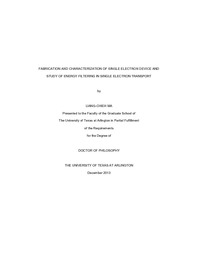| dc.description.abstract | Single electron devices, in which transport of single electrons is precisely controlled, hold a great promise as important components of future electronic devices and sensors. However, technical challenges have prevented their implementations to practical electronic and sensing systems. First of all, the fabrication of single electron devices requires their components to be defined and arranged in nanoscale precision, a great challenge for a large-scale fabrication. Secondly, for room temperature operation, the single-electron charging energy should be much larger than the room-temperature thermal energy, ~25 meV, requiring use of extremely small Coulomb island, which is difficult to control. This has limited the operation of most single-electron devices to low temperatures, requiring liquid N2 or liquid He cooling, a great obstacle for practical applications. In this thesis, I present systematic study to address these critical problems. First, I demonstrate a method which allows large scale fabrication of single electron devices using CMOS compatible processing technology. Second, I demonstrate a method that suppresses the thermal excitation of electrons and cools down electron temperature, enabling room-temperature operation of single electron devices. By analyzing the single electron device from statistical thermodynamics point of view, a model was constructed to describe single-electron tunneling events. In this model, the free energy change associated with a single tunneling event was formulated, from which the tunneling rates were calculated using the Fermi Golden rule. The I-V characteristics calculated from this model were in exact match with the widely used single electron device simulator SIMON.A new vertically aligned electrode structure of single electron device was designed and fabricated. CMOS-compatible fabrication process allowed a large scale fabrication of single electron devices. The source and drain were stacked vertically and separated by a thin dielectric layer (~10 nm). The deposition of dielectric layers was well controlled using PECVD (plasma-enhanced chemical vapor deposition) or ALD. (atomic layer deposition). Gold nanoparticles serving as Coulomb islands were attached on the exposed sidewall of the dielectric layer. Most importantly, a quantum well structure was formed between the source and tunneling barrier. The discrete energy state of the quantum well was utilized as an energy filter, serving as a key component for room-temperature operation of single electron devices.Clear Coulomb blockade, Coulomb staircase and Coulomb oscillation were demonstrated at room temperature by the fabricated single electron devices. I-V measurements done at different temperatures showed suppression in Fermi-Dirac thermal smearing. This was attributed to the electron energy filtering through the discrete energy level of the quantum well. When electron tunnels between the quantum well and Coulomb island, the energy distribution of electrons is squeezed. Through this energy filtering effect, cold electrons whose temperature is as low as ~45K can be created and transported at room temperature without physically cooling the device.Since the tunnel junctions play an important role for the single electron transport, a new structure of single electron device was proposed in order to gain more control in manipulating the tunnel junctions. A structure of silicon nanopillar single electron device was proposed and its fabrication procedure was designed. Cr nanopillars were fabricated to demonstrate the feasibility of the proposed nanopillar single electron device.In fabricating nanoscale devices, precise placement of nanoscale objects (e.g. nanoparticles) onto targeted substrate positions is critical. A new method for precise placement of nanoparticles, electrostatic funneling, was developed. In this method, the electrostatic guiding structure formed using self-assembled monolayers of organic molecules guides charged nanoparticles onto desired target positions with nanoscale precision. This electrostatic funneling method could be used to increase the yield of single electron device fabrication. | en_US |


